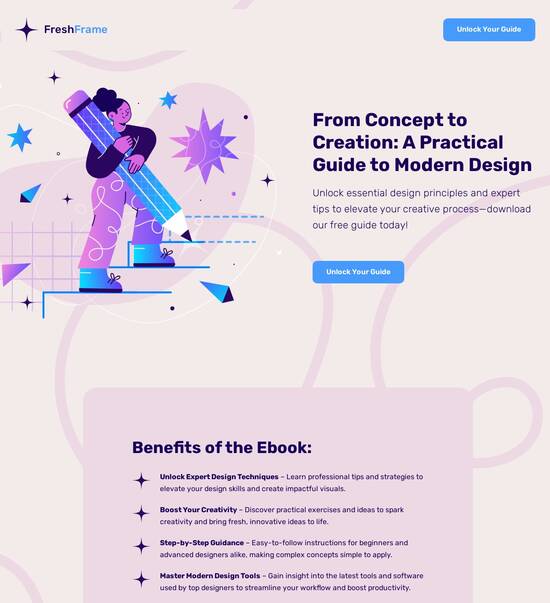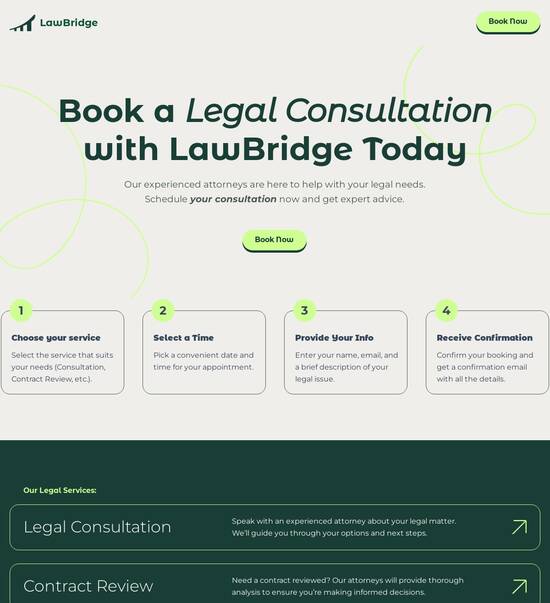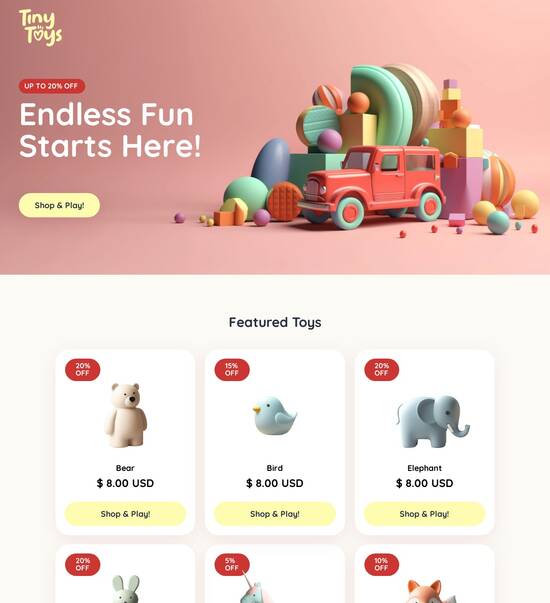
Design Internet Explorer-ready profile settings page templates
Explore Similar TemplatesAbout template
Choose the best profile settings page template for Internet Explorer
Recommended templates

Easy to build without coding
With the intuitive drag-and-drop builder, anyone on your team can create high-converting pages without any knowledge of code or design. Make enhancements to your landing page with custom widgets using Javascript, HTML/CSS, or third-party scripts.

Multiple layouts for any industry and goal
Select from 500+ landing page layouts built to boost conversions across industry-specific scenarios. Customize them by adjusting fonts, adding images, and generating on-brand content with the AI assistant. Quickly scale with Instablocks® and Global Blocks that you can save, reuse, and update globally.

Loads fast and looks polished on any device
Every template is responsive, which means they present professionally on any device and load blazingly fast with our Thor Render Engine. You can also power them up with Google AMP technology to deliver an unparalleled mobile experience and drive higher conversions.

Robust analytics & experimentation
Get real-time updates and reporting across all your devices, showing the number of visitors, conversions, cost-per-visitor, and cost-per-lead. Launch AI-powered experiments, run A/B tests, and use heatmaps to analyze user behavior, then optimize your landing page to maximize conversions.







Easy to build without coding
With the intuitive drag-and-drop builder, anyone on your team can create high-converting pages without any knowledge of code or design. Make enhancements to your landing page with custom widgets using Javascript, HTML/CSS, or third-party scripts.
Multiple layouts for any industry and goal
Select from 500+ landing page layouts built to boost conversions across industry-specific scenarios. Customize them by adjusting fonts, adding images, and generating on-brand content with the AI assistant. Quickly scale with Instablocks® and Global Blocks that you can save, reuse, and update globally.
Loads fast and looks polished on any device
Every template is responsive, which means they present professionally on any device and load blazingly fast with our Thor Render Engine.
Robust analytics & experimentation
Get real-time updates and reporting across all your devices, showing the number of visitors, conversions, cost-per-visitor, and cost-per-lead. Launch AI-powered experiments, run A/B tests, and use heatmaps to analyze user behavior, then optimize your landing page to maximize conversions.
All the features you need to build lead-generating landing pages
Explore more featuresLearn how to build top-performing landing pages for any goal
FAQs
Leading the way in building high-performing landing pages





Maximize your marketing effectiveness with Instapage's landing page and CRO platform
In the world of digital marketing, having a powerful landing page optimization (CRO) tool is crucial for maximizing return on investment (ROI). Instapage stands out as one of the most effective platforms designed for marketers across diverse verticals like Business Services, Marketing, Tech/SaaS, Education, and Financial Services in the USA. With its comprehensive features and user-friendly interface, you can accelerate and optimize your campaigns without the need for a large team or hefty budget.
Understanding Instapage's Core Features
Instapage delivers an array of features that empower marketers to build and optimize landing pages effectively. These include:
- Over 100 high-converting templates: Easily customize templates to fit your brand and capture leads.
- Built-in A/B testing: Experiment with different page versions to discover what resonates most with your audience.
- Detailed analytics: Understand user behavior through heatmaps and dashboards that provide insights into page performance.
Step 1: Building Your Landing Page
Creating a landing page using Instapage is intuitive. Follow these steps to start building your page:
- Choose a template from the extensive library that aligns with your goals.
- Use drag-and-drop features to customize your content and layout as needed.
- Preview your page to ensure mobile responsiveness and overall design.
Step 2: Optimizing for Conversions
Once your landing page is built, focus on optimization. Key strategies include:
- Implement A/B testing to evaluate various headlines, CTAs, and images.
- Utilize heatmaps to identify which elements attract the most attention.
- Personalize experiences using dynamic text replacement to match user queries.
Step 3: Measuring Success
To continually improve your landing page's effectiveness, measure your results. Important metrics to track include:
- Conversion rates to see how well your page is performing.
- Bounce rates to understand if visitors are engaging with your content.
- Source of visits to ensure your marketing channels are yielding desired results.
With these steps, you can fully leverage the capabilities of Instapage to create optimized landing pages that drive conversions and increase ROI.
Ready to transform your marketing strategy? Start your journey with Instapage today and unlock powerful landing page optimization features tailored to your needs.
People also ask about Profile settings page template optimized for Internet Explorer
Profile settings page template optimized for Internet Explorer
Understanding the profile settings page template for Internet Explorer
Creating an effective profile settings page template that functions well in Internet Explorer (IE) requires a deep understanding of both user needs and browser intricacies. Profile settings are crucial as they allow users to tailor their browsing experience directly according to their preferences. In IE, a traditionally slower-evolving browser, it’s essential to ensure compatibility while leveraging advanced settings that enhance user interaction and satisfaction.
The importance of profile settings in browsers
Profile settings are user-customizable configurations that enhance the browsing experience by enabling individuals to decide how they want to navigate the web. With these settings, users can tailor aspects such as browser behavior, security levels, and display preferences. This tailored approach greatly increases user satisfaction as individuals can create an online environment that accommodates their specific needs and habits.
As for the relevance of Internet Explorer, while its popularity has diminished over the years with the rise of more modern browsers, IE still holds a significant presence in many enterprise environments. Organizations often rely on IE due to legacy applications and systems that are tightly integrated with the browser, thus making the profile settings page template critical for maintaining efficient workflows and security compliance.
Key features of the profile settings page template
The user interface design for the profile settings page should prioritize clarity and simplicity, ensuring users can easily navigate through their options. The layout must be optimized for Internet Explorer's rendering engine, which tends to require more straightforward structures compared to modern browsers. Clean lines, well-organized menus, and adaptive elements that respond to user actions can significantly enhance usability, making it easier for users to find what they're looking for.
Color contrast and font sizing are also important; adopting a high-contrast color scheme can elevate readability, making settings accessible for all user demographics, including those with visual impairments. Customization options should allow users to choose themes that reflect their aesthetic while preserving functional clarity. Additionally, implementing group policy administrative templates can streamline settings for business environments, providing an avenue for centralized configuration choices.
Clean and intuitive layout optimized for Internet Explorer.
Adaptive elements for enhanced usability.
Contrast and color considerations for readability.
Personalized themes and skins tailored for individual preferences.
Technical specifications and compatibility
Ensuring compatibility with various versions of Internet Explorer is crucial for any profile settings page template. Developers should note the need to support at least IE 11, the last version supported by Microsoft, as many enterprises still use it due to compatibility with older systems. Testing templates on different versions ensures that all users have a smooth experience, regardless of what version they are running.
For organizations utilizing legacy systems, it’s vital to optimize code for performance in IE. This includes minimizing reliance on modern JavaScript features without polyfills. HTML standards should be adhered to, as IE can struggle with non-standard coding practices. Developers can utilize IE-specific polyfills and patches to facilitate functionalities that are otherwise unsupported, ensuring seamless user experience.
Supported versions of Internet Explorer for profile settings templates.
How to ensure compatibility with legacy systems.
Step-by-step guide to creating a profile settings page
Planning the layout is the first step towards creating a well-structured profile settings page. Starting with a wireframe allows you to visualize the interface before coding begins. Essential components should include a header with navigation, a body section housing the settings options, and a footer for additional information or links. Each section must cater to user needs with logical ordering, ensuring visitors understand where to look for specific settings.
When implementing features, ensure you cover essential user preferences such as language settings, privacy options, and accessibility features. Each of these should be customizable with clear instructions on how users can apply these settings. Lastly, troubleshooting common issues is crucial; be prepared for compatibility problems and provide effective solutions, such as checking for outdated scripts or unsupported tags within the layout.
Language settings.
Privacy options.
Accessibility features.
Group policy administrative templates and their impact
Group policy administrative templates allow for consistent management of browser settings across an organization, providing IT administrators with tools to enforce specific configurations. These templates can be tailored to ensure all users adhere to corporate guidelines while retaining the ability to personalize to a certain extent. This balance between user choice and corporate compliance is essential for any enterprise utilizing IE.
When implementing administrative templates in Internet Explorer, the configuration process is streamlined through a logical structure that allows admins to set parameters that will be uniformly applied. Best practices suggest regularly updating these templates to reflect changes in browsers or security compliance requirements, preventing vulnerabilities from arising due to outdated settings.
Overview of what Group Policy Administrative Templates are.
Steps for configuring templates for profile settings.
Enhancing security through profile settings
Security is a vital aspect embedded within the profile settings page template. By encrypting user data and implementing strong access controls, organizations can safeguard against unauthorized access and data breaches. Security features should focus on robustness while maintaining user convenience without complicating the process too much. For instance, easy-to-navigate privacy settings can prompt users to change configurations that protect their identities and information.
Administrative controls provide further layers of security, allowing administrators to monitor user activities and ensure compliance with organizational policies. Such controls allow setting restrictions or granting permissions based on user roles. Moreover, the inclusion of robust reporting features within the settings page empowers admins to analyze usage patterns and potential security gaps, ensuring a proactive approach to monitoring.
Encryption of user data within the profile settings.
Measures to protect against unauthorized access.
Advanced customization and scalability
To create a scalable profile settings page template, developers need to consider how requirements may evolve as organizations grow. The design should accommodate additional features over time without fundamental redesigns. This forward-thinking approach enables organizations to adapt to new user needs and technological advances without significant resource investment.
User feedback mechanisms can play a crucial role in this process, allowing real-time insights on user experience. By integrating feedback tools directly into the profile settings, organizations can gather metrics and sentiments that directly link to user satisfaction. Additionally, the continuous analysis of this data can reveal trends and demand for updates, ensuring the template remains relevant.
Strategies for creating templates that grow with the organization.
Integrating functionality that adapts to different users within the organization.
Real-world applications and case studies
Many organizations have successfully adopted the profile settings page template to enhance their internal browser experience. For instance, a financial services company noted improved efficiency after implementing a tailored settings page that allowed employees to modify their privacy settings instantly. Such simple adjustments lead to a measurable increase in employee productivity and satisfaction.
Testimonials from users provide further evidence of the impact these templates have. One university highlighted how centralized control over browser settings helped maintain compliance with educational standards while allowing students to personalize their studies. With various users experiencing the advantages of tailored settings, these templates prove valuable in virtually any context discreetly and efficiently.
Examples of organizations successfully implementing profile settings.
Measurable benefits observed post-implementation.
Future trends in browser profile management
Looking ahead, Internet Explorer's role may diminish as organizations migrate to modern browsers; however, legacy systems will play a pivotal role in determining continued usage. Future trends point towards an increasing demand for enhanced communication between browsers and organizational frameworks, streamlining profile management. As secure cloud services become more mainstream, the ability to manage user profiles remotely is likely to emerge.
Anticipated innovations could include better machine learning capabilities to automate settings based on usage metrics. Features such as intelligent adaptive settings that change according to user behavior could enhance productivity and engagement within a browser environment. As technology evolves, the integration of new capabilities will reshape how organizations perceive and utilize profile management.
Market trends and legacy system impacts on IE usage.
The evolution of profile management templates.
Summary of key takeaways
Creating an optimized profile settings page template for Internet Explorer allows organizations to enhance user experience and manage browser behavior effectively. By understanding the balance between user preference and organizational needs, developing customizable options becomes essential. Implementing security measures and anticipating future changes in technology will ensure that these templates remain relevant and efficient.
Ready to skyrocket conversions?
Supercharge your ad campaigns with high-performing landing pages
Get started














